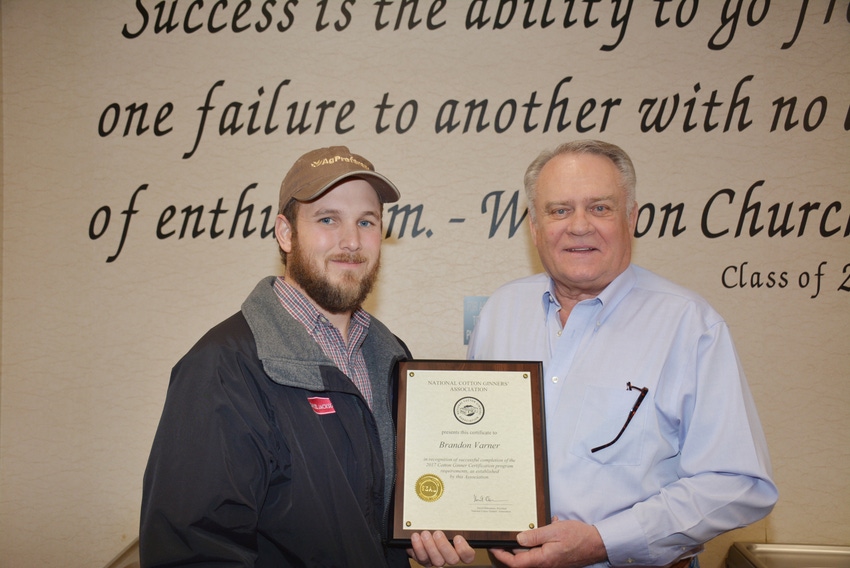
In Frederick, Okla., gin manager Brandon Varner is learning to grow what he gins while also becoming a certified ginner.
“Dad and I are traditionally wheat growers who switched to cotton a couple of years ago. We always dabbled in it some but never to the extent that we are now,” says Varner. “Some of the challenges we’ve had are learning how to manage a cotton crop that’s growthy like this. It’s been a wet year so this cotton really tried to grow off into a tree, and trying to manage that in a dryland situation, not really knowing what rainfall and Mother Nature has in store for you, has been challenging.”
To work through the difficulties, the father/son duo has sought the advice of neighbors, people at the gin and by attending meetings such as the Red River Crops Conference at Altus, Okla., to learn more about cotton and how to manage it.
“Meetings like this are very helpful and a big reason that we are here today. I’ve got a degree in agricultural economics so I really enjoy the marketing. It’s always a challenge to know when to buy and when to sell. As far as growing it, we’re dealing with resistant weeds and as far as being good neighbors, that’s another reason we’re here, to learn the new rules about the new technology.”
Varner’s partnership with his father works well because they both bring something unique to farming. “There’s new technology. I’m younger and more apt to figure it out—my dad relies on me for that. And I rely on his experience. We go back and forth that way, keeping an open mind on what’s worked in the past.”
See Red River Crops Conference offers growers management, production information for 2018, http://bit.ly/2E6iUSX
As Varner looks to the next crop year, he says, “We hope we can do it again in 2018. We needed to start rotating ground. Traditionally, we’ve been a wheat, stocker cattle operation. It’s gotten so costly to grow this wheat and then the price, that we’re exploring cotton as an option. Economics has pushed us to it.”
Ginning
Growing cotton isn’t the only challenge Varner faced in 2017. As Tillman Producer Co-op’s gin manger, he and his gin crew have also been ginning a record number of bales for the second consecutive year, racing against time to finish 2017 so they can prepare the gin for the 2018 crop.
“Last year we ginned a record number of bales for our gin at 50,300 bales. As of this morning, we’ve ginned 53,000 and we’ve got enough tagged in to get to 93,000 bales,” says Varner. “It’s been a long, trying year. We are going to see how many bales we can get through this gin.”
And while this bumper crop has been demanding, Varner makes the point that it’s also a boon. “The crop is a blessing, both for us and our producers and I’m really proud of our crew that’s ginning it.”
The Tillman gin is equipped with four Lummus 116 model gin stands. On “really good cotton,” Varner says, his gin can bale about 41 bales per hour, “that’s top end.” More generally, they’re running about 37bales per hour. “Overall, the quality has been good. It’s been a real blessing to have quality and quantity on this crop,” he says.
Oklahoma is expected to gin a bumper 1.1 million bales of cotton from the 2017 season. To prepare for the increase, Varner says they sped up the press and overhauled the gin stands to try to increase capacity. “We basically repaired everything we could think of to prepare for this large crop.”
Recognition
While Varner has been ginning record crops, he’s also been working on his Cotton Ginner Certification, something he was recognized for completing at the conference.
Varner was presented a plaque by Harvey Schroeder, executive director of the National Cotton Ginners’ Association, for his completion of the three-year program and passage of a comprehensive written exam covering practical aspects of gin operation.
The push
As his gin runs 24/7 trying to bale up the 2017 season with hopes of finishing by the end of April, Varner says he’s already concerned about having the gin ready for what is expected to be an even larger cotton crop in 2018. “The biggest thing is the time table and getting this gin repaired and ready to go for the next go-round,” says Varner. “So, we’re going to hit it hard, have a lot of parts on hand and get ready to start tearing into it and repairing. It’s just the time constraint to get it done is going to be a push but it will be doable.”
See Dicamba training begins, detailed documentation required, http://bit.ly/2no0z9o
About the Author(s)
You May Also Like






